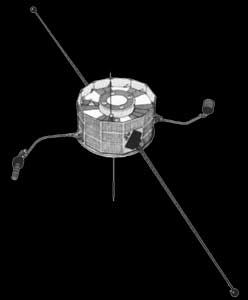
Home - Search - Browse - Alphabetic Index: 0- 1- 2- 3- 4- 5- 6- 7- 8- 9
A- B- C- D- E- F- G- H- I- J- K- L- M- N- O- P- Q- R- S- T- U- V- W- X- Y- Z
AMPTE
 AMPTE 2 Credit: Manufacturer Image |
AKA: CCE;Charge Composition Explorer. Status: Operational 1984. First Launch: 1984-08-16. Last Launch: 1984-08-16. Number: 4 .
NASA NSSDC Master Catalog Description
The AMPTE (Active Magnetospheric Particle Tracer Explorers) mission was designed to study the access of solar-wind ions to the magnetosphere, the convective-diffusive transport and energization of magnetospheric particles, and the interactions of plasmas in space. The mission consisted of three spacecraft: the CCE; the IRM, which provided multiple ion releases in the solar wind, the magnetosheath, and the magnetotail, with in situ diagnostics of each; and the UKS, which uses thrusters to keep station near the IRM to provide two-point local measurements. The CCE (Charge Composition Explorer) spacecraft was instrumented to detect those lithium and barium tracer ions from the IRM releases that were transported into the magnetosphere within the CCE orbit. The spacecraft was spin-stabilized at 10 rpm, with its spin axis in the equatorial plane, and offset from the earth-sun line by about 20 deg. It could adjust attitude with both magnetic torquing and cold gas thrusters. The CCE used a 2.E8-bit tape recorder and redundant 2.5-W S-band transponders. The spacecraft battery was charged by a 140-W solar array. The PI for the U.S. AMPTE Program and for the CCE was S. M. Krimigis (now Richard McEntire of JHU/APL); each instrument was managed by a lead investigator. The CCE encountered command module/power supply problems since the beginning of 1989, and failed as of 12 July 89. For more details, see J. Dassoulas et al., IEEE Transactions on Geoscience and Remote Sensing, Vol. GE-23, p. 182, 1985.
More at: Explorer cce.
| CCE (AMPTE 1) Null |
| IRM (AMPTE 3) Null |
| UKS (AMPTE 2) Null |
Family: Earth, High earth orbit, Magnetosphere sat. Country: USA. Launch Vehicles: Thor, Delta, Delta 3924, Delta 3000. Launch Sites: Cape Canaveral, Cape Canaveral LC17A. Agency: NASA. Bibliography: 2, 279, 6, 12047.
 | AMPTE 3 Credit: Manufacturer Image |
1984 August 16 - . 14:48 GMT - . Launch Site: Cape Canaveral. Launch Complex: Cape Canaveral LC17A. LV Family: Thor. Launch Vehicle: Delta 3924.
- CCE-1 - . Payload: Charge Composition Explorer 1. Mass: 242 kg (533 lb). Nation: USA. Agency: NASA. Class: Earth. Type: Magnetosphere satellite. Spacecraft: AMPTE. USAF Sat Cat: 15199 . COSPAR: 1984-088A. Apogee: 49,671 km (30,864 mi). Perigee: 1,121 km (696 mi). Inclination: 4.80 deg. Period: 939.50 min. Charge Composition Explorer; detected tracer ions released into magnetosphere by IRM. Spacecraft engaged in research and exploration of the upper atmosphere or outer space (US Cat B). .
- AMPTE 2 - .
Payload: AMPTE-IRM Ion Release Module 1. Mass: 605 kg (1,333 lb). Nation: Germany.
Agency: DLR.
Class: Earth.
Type: Magnetosphere satellite. Spacecraft: AMPTE.
Decay Date: 1987-12-08 . USAF Sat Cat: 15200 . COSPAR: 1984-088B. Apogee: 113,818 km (70,723 mi). Perigee: 402 km (249 mi). Inclination: 27.00 deg. Period: 2,653.40 min.
Released barium, lithium ions into magnetosphere for detection by CCE, UKS. AMPTE-Ion Release Module, reg. no. D-R 002. Scientific research on the Earth's magnetosphere and plasma physics, in particular active experimentation by releasing ion clouds of lithium or barium (total of 7) in and outside the magnetosphere. Creation of a n artificial comet (1 barium cloud inside the magnetosheath). Diagnosis and experimentation in conjunction with the simultaneously launched satellites CCE (United States) and UKS (United Kingdom).
- AMPTE 3 - . Payload: AMPTE-UKS UK Subsatellite. Mass: 77 kg (169 lb). Nation: UK. Agency: SRC. Class: Earth. Type: Magnetosphere satellite. Spacecraft: AMPTE. Decay Date: 1990-02-21 . USAF Sat Cat: 15201 . COSPAR: 1984-088C. Apogee: 113,417 km (70,473 mi). Perigee: 1,002 km (622 mi). Inclination: 26.90 deg. Period: 2,659.60 min. Detected tracer ions released into magnetosphere by IRM. Magnetosphere research satellite. Launch time 1447 GMT. (Document quotes geocentric distances, which have been converted to orbital heights.).
- Solar Cell Experiment - . Payload: STP. Nation: USA. Agency: NASA Greenbelt. Spacecraft: AMPTE. USAF Sat Cat: 15202 . COSPAR: 1984-088D. Apogee: 4,019 km (2,497 mi). Perigee: 546 km (340 mi). Inclination: 28.92 deg. Period: 133.62 min.
Back to top of page
Home - Search - Browse - Alphabetic Index: 0- 1- 2- 3- 4- 5- 6- 7- 8- 9
A- B- C- D- E- F- G- H- I- J- K- L- M- N- O- P- Q- R- S- T- U- V- W- X- Y- Z
© 1997-2019 Mark Wade - Contact
© / Conditions for Use